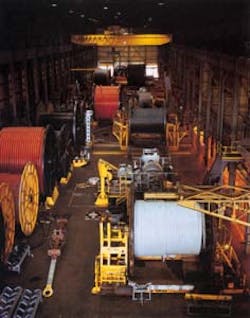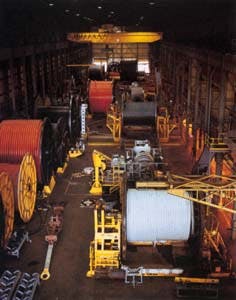Subsea Merger Wellstream, Subtec buys create new force in underwater technology
Expansion of Dresser division coincides with launch of modular pipelay system
David Barnes
SubSea Offshore
- Operating principle of SubSea Offshore's newSnapLay modular pipelay system as planned for the laying of two km of 24-in. pipeline for BP's North Sea Harding Field this summer.
Production of non-bonded flexible pipes at Wellstream's main plant in Panama City, Florida.
Following recent acquisitions of Subtec Asia and Wellstream by its parent organization Dresser Industries, Aberdeen-based SubSea Offshore has entered a new phase of development. Not only do these acquisitions extend its global capability, but they also consolidate the company's position in underwater technology as the world's largest manufacturer and operator of ROVs.
Both acquisitions follow an earlier collaborative agreement reached last year between SubSea Offshore and Ugland UK under which the two companies aim to jointly service subsea construction markets, initially within the UK sector of the North Sea.
As such, this venture offers integrated solutions for subsea engineering projects by providing single package steel and flexible pipeline installation, lifts up to 600 tons, tie-ins and ROV tooling together with survey, diving, project management, and engineering support.
Support vessels for construction, diving, survey, and ROV applications are among the most advanced of their type and include Ugland's Nordica, Fennica and Maxita in addition to SubSea's own DSV SubSea Mayo and ROVSV Kommandor SubSea.
Eastern extension
The acquisition by Dresser last November of Subtec Asia effectively extends SubSea's geographical limit throughout the Middle and Far East while also adding to its existing portfolio of engineering and support resources.
Based in Sharjah, UAE, and with operating bases throughout the Middle East as well as Brunei, Singapore, and Vietnam, Subtec maintains its own fleet of ten vessels and barges for a range of services extending from underwater surveying, trenching and diving to laying of pipes and cables.
The company is also noted for in-house development of systems such as the Pelican and Toucan series of submersible, crawler-mounted trenchers (SCMTs) for underwater cable protection.
Hydraulically powered and designed for operation aboard non-specialized support vessels, the Toucan series in particular can lay/trench or post-lay/trench submarine cables, umbilicals and flexible pipelines up to 160mm diameter in both shallow and deep water: trenching is possible in all types of soil formation at depths up to 2.1 metres.
With the growing number of subsea developments, particularly in deep waters where flexible flowline/riser systems are now increasingly preferred, the acquisition of flexible flowline manufacturer Wellstream adds a further new dimension to SubSea Offshore's activities.
Based in Panama City, Florida, Wellstream is an emerging force in the design and manufacture of non-bonded flexible pipe products, and is also a key supplier to major offshore operators such as BP, BHP, Conoco, Mobil, and Petrobras. Recent contracts include supply of over 13,000 ft of 7-in. flowline piping for Norsk Hydro's Gamma Nord project in Norway.
Non-bonded pipe structures consist of concentric extruded polymer and reinforcing helical metallic layers, with engineering based on conveyed fluid composition, operating pressure, water depth, and likely service conditions. All hold Lloyd's Registry ISO 9001 type-approval for pressure ratings up to 10,000 psi.
The resultant merging interests will bring SubSea Offshore and Wellstream together to offer an integral design, build and installation service for flowline and riser systems. Fabrication will continue to be carried out in Florida while it is anticipated that SubSea's 120 metre long pipelay vessel Discovery will be responsible for installation.
SnapLay
These two merger ventures coincide with SubSea Offshore's own recent development of a novel proprietary modular pipelay system which could fundamentally change the way in which fields are developed, called SnapLay. The technique allows pipes and coatings to be designed exclusively for on-bottom service, without any need to withstand loadings associated with conventional laying techniques.
SnapLay, which incorporates the established Merlin S series of reusable, non-rotational underwater connectors developed by Hunting Oilfield Services for open-hole installations and platform tie-backs, also enables laying of larger diameter pipelines from smaller, more economic vessels.
Moreover, connectors and spools are available in a wide range of materials, making the system particularly suitable for specialist service applications. For seabed connections, snap-link spool pieces can include any feature from Y pieces and ESVs to entire protective structures.
The system's first application will be the make-up this summer of two km of 24-in. pipeline for BP's North Sea Harding Field development. Planned installation methods here involve firstly laying of 72 metre spools accurately positioned by guidewires from Ugland's MSV Maxita, with make-up of Merlin connectors being carried out by an underwater crawler deployed from SubSea's DSV Mayo.
Make-up tools comprise a mobile frame with three clamps run on tracks. The crawler vehicle is then positioned over the pipeline and spool ends. The first clamp manipulates the pipeline in an X and Y plane while a second grips and manipulates the spool-end and, with two metres of longitudinal travel, inserts the pin of the connector into the box.
A make-up clamp is then deployed over the two connector halves, pressure-injected to separate the teeth, and make-up force is then applied. The crawler subsequently releases the pipe and proceeds to the next designated connection.
While the innovative aspects of SnapLay are essentially based on adaptation of a proven technology to other sectors of offshore operations, its commercial potential is nonetheless significant. For example, additional prospective applications could well include J and S lays using a variety of vessel types, including SubSea's own lay barges.
Copyright 1995 Offshore. All Rights Reserved.

